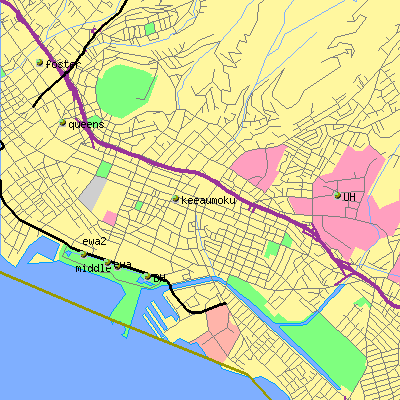
Knowing what a threat they are to small asteroids, I decided to start hunting baobabs around honolulu. Fortunately, they turn out not to be a major threat in Honolulu -- unlike, say guava (a pervasive imported tree), miconia (an aggressive tree that would definitely take over if it were allowed to), and brown tree snakes. Someone who has spent much more time than I thinking about this has concluded that baobabs (adansonia digitata) are a low risk of being an invasive species on pacific islands.
At any rate, my hunting has been fruitful. Here is a map of the locations I have found.

I created this map from the following GPS positions using the tiger mapping service, provided free of charge by the US census bureau. Instructions for making your own maps are here. Note that when GPS positions are plotted on Tiger an offset is needed -- probably due to Tiger using a different datum than my GPS.
I am interested in baobabs in Honolulu, but by which definition of Honolulu? All the baobabs I have found so far are both within the City of Honolulu, as understood by the US postal service, and within the City and County of Honolulu, which includes the entire island of Oahu. The City and County includes the city of Honolulu, the rest of the island of Oahu, and most of the Northwestern Hawaiian Islands, on which I suspect few if any baobabs are found.
I would not be surprised to find out there may be baobabs in Ho'omaluhia Botanical Garden, the only place so far which would fit the second but not the first definition of "Honolulu", and which has a section on African plants. There may be more, of course -- that's the fun of hunting baobabs.
At any rate, the ones I have found are the following:
All the baobabs I have found so far have been labeled (if anything) "Adansonia Digitata". Apparently, there are at least 8 different species of Adansonia, most from Madagascar, though one, commonly referred to as "Boab", is from Australia.
Back to my personal page.